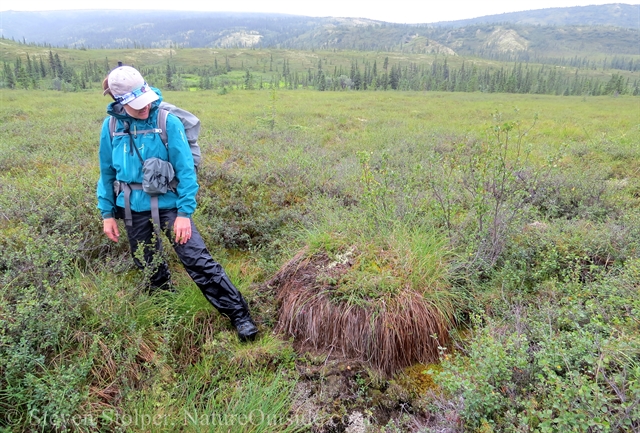
So, this is Alaska!
I smile. As I stand outside in the early morning, Alaska looks a lot like the inside of a fog bank. Rain, just barely more than mist, patters on the hood of my rain jacket. I look down at my blue rain pants. I haven’t worn them in years.
It’s August in Denali National Park. And it has rained every day for the last week. It’s the worst storm of the summer. The rivers are gushing and the mountains lost in low cloud. Denali, at 20,310’ is the highest peak in North America. Yet all I see to the south are clouds to the horizon. I idly wonder if “Mt. Denali” is an elaborate hoax, perpetrated by the locals to lure unwitting tourists thousands of miles to interior Alaska.
Even nearby ridgetops are obscured by clouds. I have the extraordinary impression of standing in an enclosed room. A green expanse of carpet stretches for miles, with granite walls rising to a gray ceiling overhead.
This article contains affiliate links.
Tundra Ho!
Our small group of hikers gathers in the courtyard in front of our lodge. We’re 90 miles from the park entrance, deep in the backcountry.
My excitement is not diminished by the rain, nor by the 50-degree temperature. We all plan our vacations with visions of blue skies and endless sun. But the reality is weather. The sooner we accept it, the more fun we have as travelers.
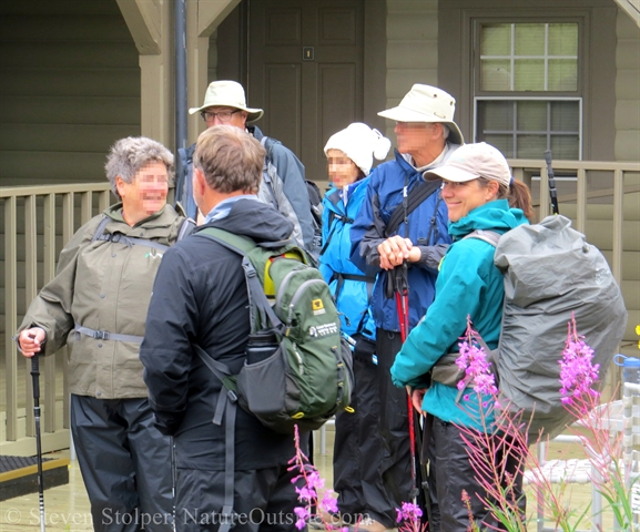
Our group gathers for the hike. Jenna, our guide, is on the far right. The pink flowers are Fireweed.
My interior landscape is not as bleak as the weather. I’m about to experience tundra! Many years ago, I hiked across tundra on New Zealand’s South Island. I’ll never forget the experience of bouncing up and down like I was walking on a trampoline. This is my chance to experience tundra again! I can’t repress my excitement. Anticipation warms me from within as much as my breakfast of scrambled eggs and Reindeer sausage.
Our guide, Jenna, is also an owner of the lodge. She was raised here. And it’s our good fortune to have a guide who knows the area so intimately.
We set out on foot to explore the tundra.
Moose Creek
Jenna guides us on a circuitous route that allows us to explore riparian habitat nearby.
Some species I recognize, and some I don’t. I walk with the eyes of a stranger, seeing the land for the first time.
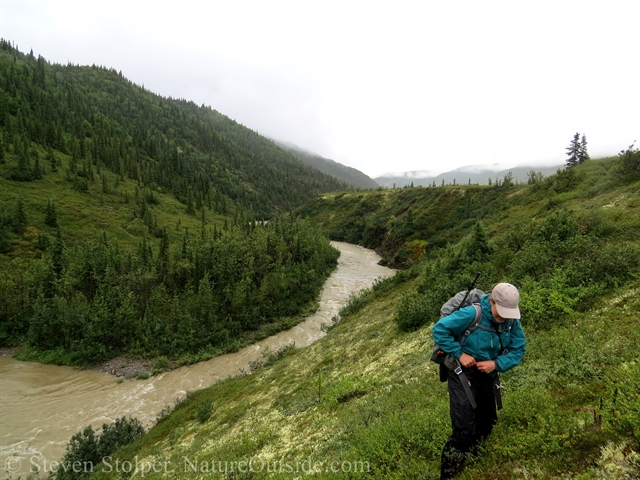
Moose Creek, Denali National Park. The creek is gushing from the persistent rain.
There’s plenty of fungus in this moist environment.
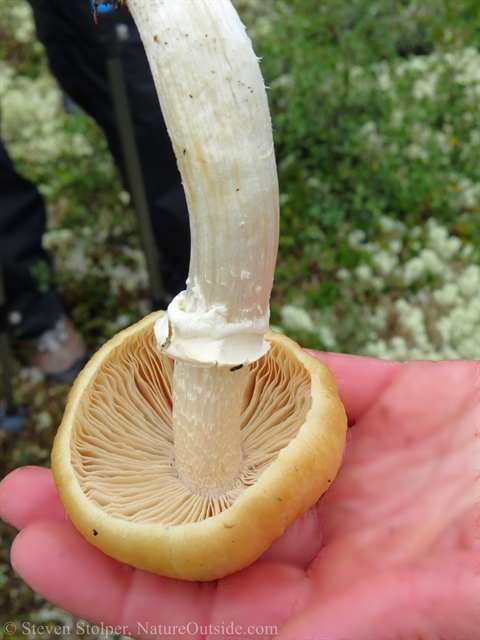
A Cortinarius mushroom we find on our hike. Notice the annulus (ring) on the stipe (stem). It is the remains of the partial veil that protects the gills while the spores are developing.
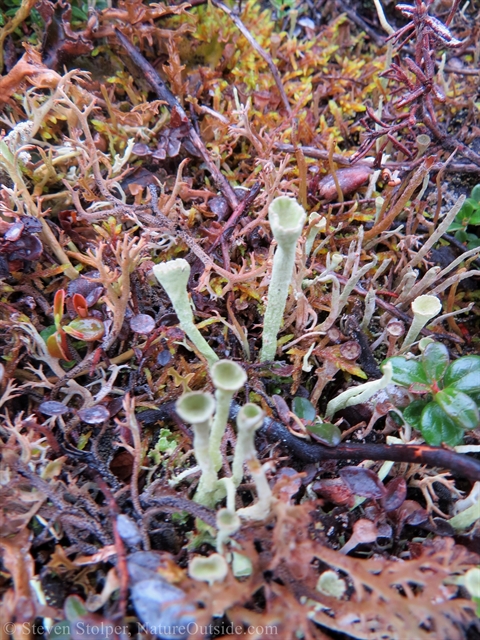
I love this beautiful cup lichen (Cladonia sp.)
Beside a rushing creek, we stop to taste some Mountain Sorrel (Oxyria digyna). Despite its common name, it’s actually in the Buckwheat family. It gets its name from its sour-tasting leaves, like my favorite plant, Wood Sorrel. And just like Wood Sorrel the leaves contain oxalic acid, and are edible both raw and cooked. But they miss the pleasant “apple candy” flavor of the oxalis I find in the redwood forest. There’s no rush of joy or surprise from nibbling a Mountain Sorrel leaf.
Jenna mentions that the leaves stimulate the flow of saliva, and can be used to stave off thirst.
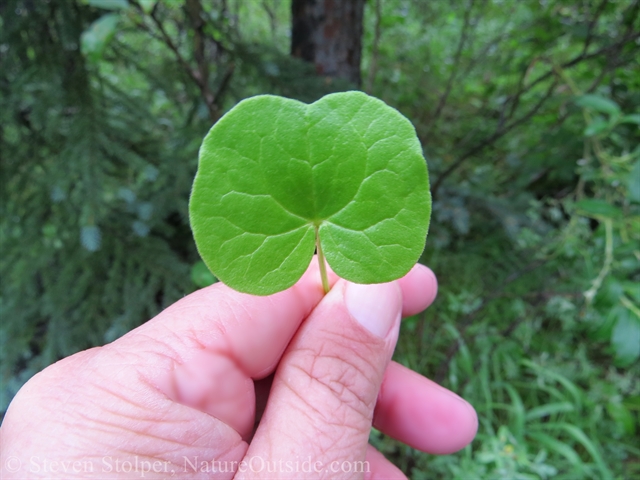
Mountain Sorrel leaf
Another plant grabs my attention. It’s growing among the Mountain Sorrel. I’ve never seen it in person, but Jenna confirms my suspicions: Monkshood (Aconitum delphinifolium)!
Monk’s Hood is poisonous! In fact, it’s deadly. The entire plant contains highly toxic cardiotoxins and neurotoxins1. Supposedly, the plant has a distinctive and unpleasant taste. But I have no desire to confirm this. Native people of Alaska’s Aleutian Islands hunted whales with harpoons tipped with poison concocted from this plant.
There are also tales of its poison being used for murder. One of my favorite fictional detectives, the medieval monk Cadfael, is called to solve a case where Monkshood is the instrument of death. If you get a chance, PBS made the story into an episode of “Mystery” that you can watch on DVD. Actor Derek Jacoby gives an outstanding performance as Cadfael.
The flowers do indeed resemble a monk’s habit. And I admire the indigo flowers and spidery leaves.
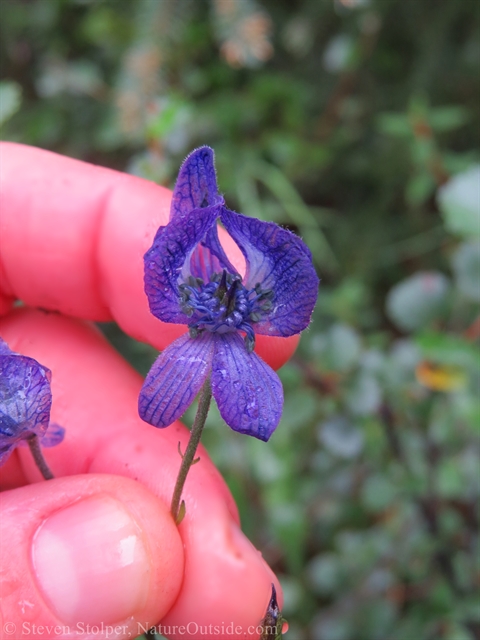
Monkshood flower
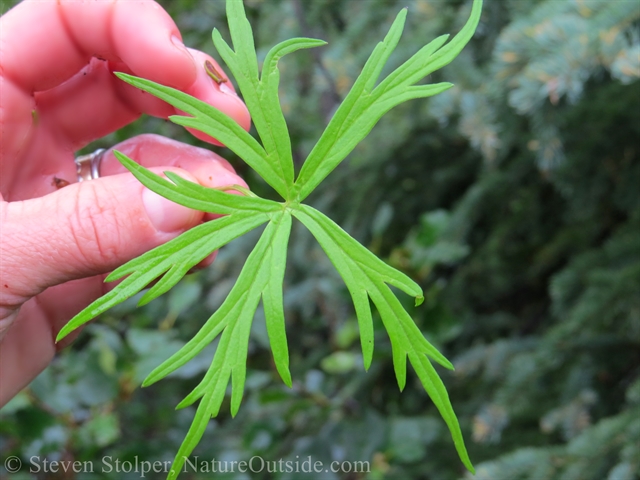
Monkshood leaf
We leave the riparian habitat and continue toward the tundra.
As we go, I ask a question that’s been puzzling me. I recognize birch trees from my childhood in New York. But there are also birch-looking trees with “copper-gold” bark instead of pure white.
Jenna explains that the trees are Balsam Poplar (Populus balsamifera), and suggests I scrape off the outer bark to see what’s underneath. I prune a small branch and use the spine of my knife to scrape down its length. A wonderful scent arises from the cutting. Jenna explains that the tree is sometimes referred to as the “Balm of Gilead.” Its leaf buds are coated with a resinous sap that has a strong, pleasant odor. It smells like turpentine, but with the pleasing sweetness of a French perfume. It’s no surprise that the aromatic leaf buds are used as an ingredient in potpourri and herbal medicines.
When I scrape away the outer bark, I discover a photosynthetic layer underneath translucent bark. Very cool!
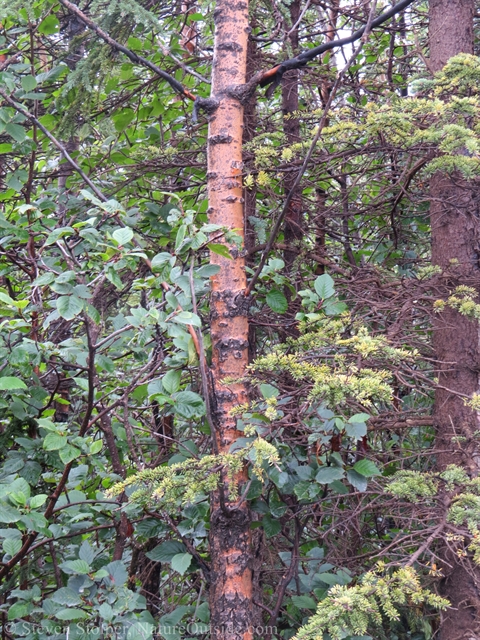
Balsam Poplar
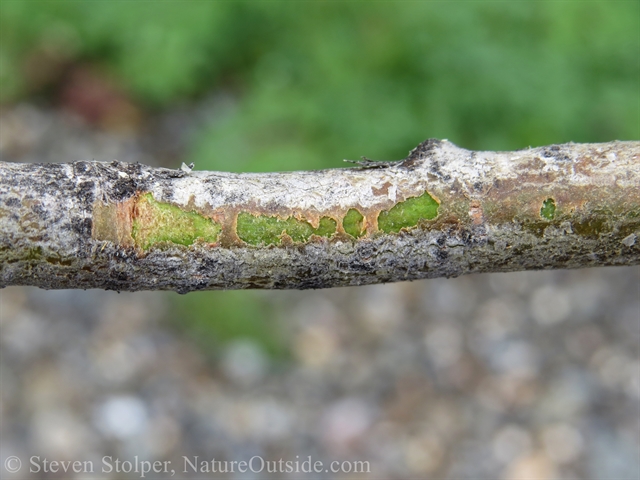
Beneath the outer bark I find a photosynthetic layer.
Wet Tundra
Finally, we make our way onto the tundra! You can read all the books you want, but nothing comes close to direct experience of the living world. This is why I traveled so far from home.
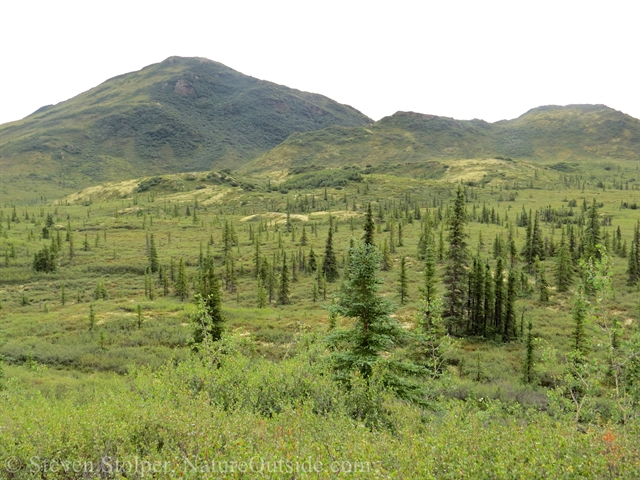
Tundra!
Suddenly, movement catches my eye. I see what appears to be a pale-white raptor swooping to perch on a distant spruce. The bird looks huge! As I raise my field glasses, Jenna identifies it as a short-eared owl.
I check my movement. Surely, she’s made a mistake. I glance at my watch to confirm that it’s still early morning. Most owls in California are nocturnal. What’s the deal? Jenna explains what with hindsight seems obvious. When days have 17+ hours of sunlight, you’ll starve to death if you only hunt in darkness. Today, the sun rose at 5:39 am and won’t set until 10:38 pm. Good luck being nocturnal in the Alaska summer!
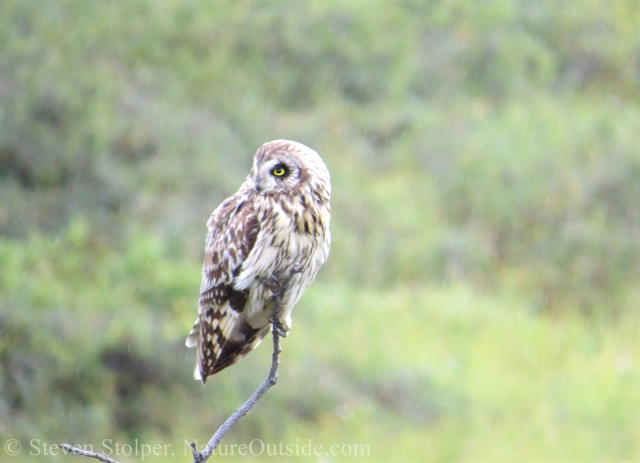
Short-eared owl
My rain pants swish as we hike onto a great sward of tundra.
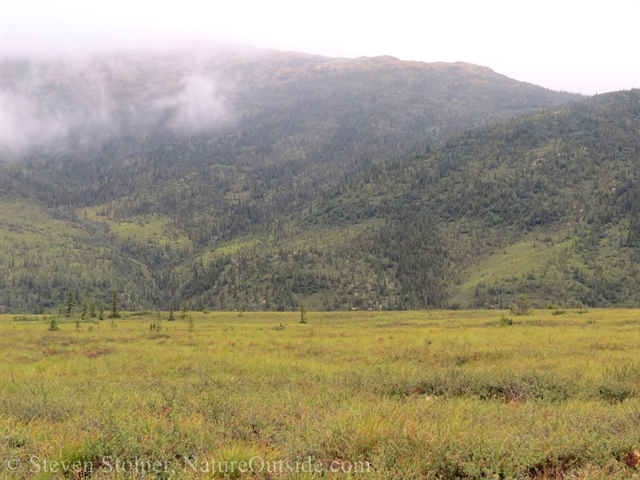
A view of the tundra
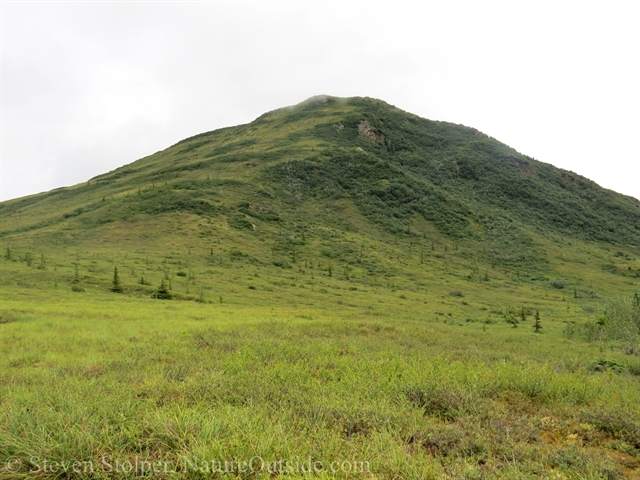
The tundra is remarkably flat, with a few hills rising near the edge of the valley.
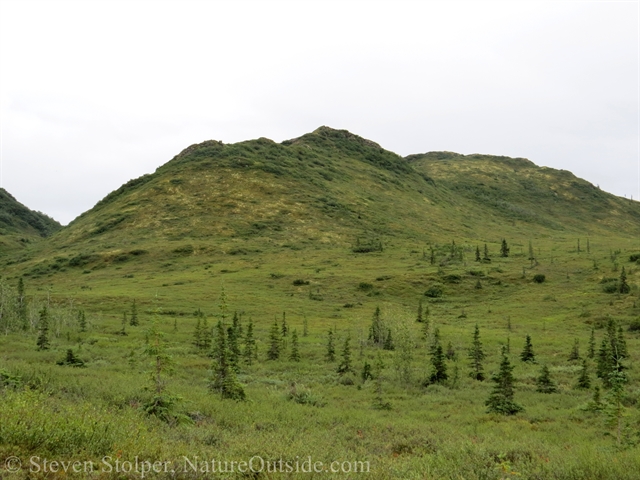
Tundra
Tundra and Permafrost
It’s worth spending a moment to ponder the question: What is tundra anyway?
To understand tundra, you need to start with permafrost. I discussed this briefly in my previous article. Essentially, the ground is frozen solid, year-round, 6-12 feet below the tundra’s surface. It’s estimated that permafrost is found to some extent beneath nearly 85% of Alaska.
Many parts of Alaska see little precipitation, and are actually arid. But the permafrost forms an impenetrable barrier to water like concrete beneath the surface. Rainfall and snowmelt do not drain through the ground. Instead, water collects at the surface.
The water nourishes plants and forms shallow lakes that provide food and water for animals. The plants return the favor by insulating the permafrost beneath them so it remains frozen throughout the year. You can estimate the depth of the permafrost below by looking at the size and species of plants that grow at the surface. The contrast between areas with permafrost and patches without it are striking!
Permafrost creates the taiga, tundra, and boreal forest ecosystems we see in the subarctic. But studies show that much of the permafrost in Alaska is warming significantly, and some of it is thawing. If the permafrost thaws, the entire ecosystem will change from what we know today. In addition, thawing permafrost may actually release methane and carbon dioxide gases into the atmosphere, which would further accelerate global warming. If humans do not take steps to address the global warming we create, our children will never see the incredible subarctic scenery I’m enjoying.
The Tundra Surface
Two organisms seem to dominate the wet tundra: Sphagnum Moss and Reindeer Moss.
Sphagnum Moss
Sphagnum moss forms huge colonies on the surface of the soil. Together, the plants act like a giant sponge. They can absorb close to 16 times their weight in water. The dried moss has been used throughout history for its absorbent qualities and for its mild antiseptic properties. Traditional uses include wound dressings, diapers, and “bubble wrap” for precious items. I first encountered sphagnum moss years ago as a growing medium for orchids. I used the moss’s water absorbing properties to help me grow orchids in California’s arid climate.
It’s Sphagnum Moss’ ability to thrive in wet, poor soil that allows the plant to dominate this environment. And it’s the carpet of Sphagnum moss that provides the springy “trampoline effect” when you walk. I can’t get enough of bouncing up and down as I stroll across the tundra!
Reindeer Moss
Despite its name, Reindeer moss isn’t a moss at all. It’s a lichen! This is the first time I’ve seen it, and I marvel at its sculptural appearance.
Ancient cultures across the northern forests used Reindeer moss for food. But in a roundabout way. The moss is filled with acids that the lichen uses to extract nutrients from the poor soils in which it grows. But Caribou/Reindeer have the ability to digest it. The digested Reindeer moss is edible by humans, and an important source of carbohydrates and vitamins. When people killed a Reindeer, they froze the stomach and then sliced its contents into sections for storage. The pre-digested Reindeer moss could be used to thicken stews and bring an important vegetable content to winter meals.
Reindeer moss is also useful for route finding. Jenna points out that it usually grows on raised ground that is dryer and firmer than the surrounding tundra. So walking on Reindeer moss is easier than on Sphagnum moss.
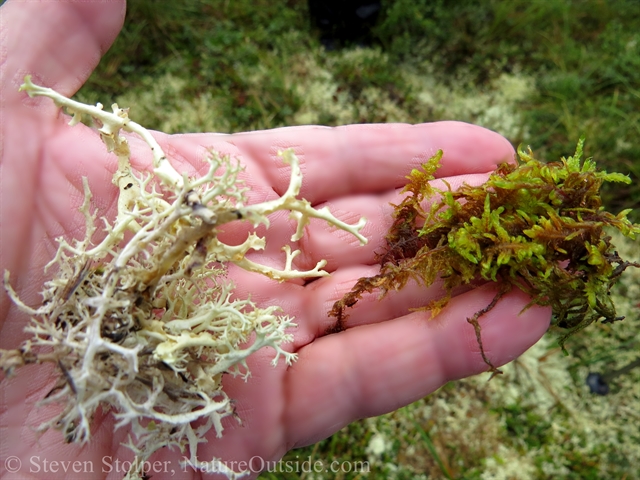
Reindeer moss (L), really a lichen, and Feather moss (R) carpet the ground.
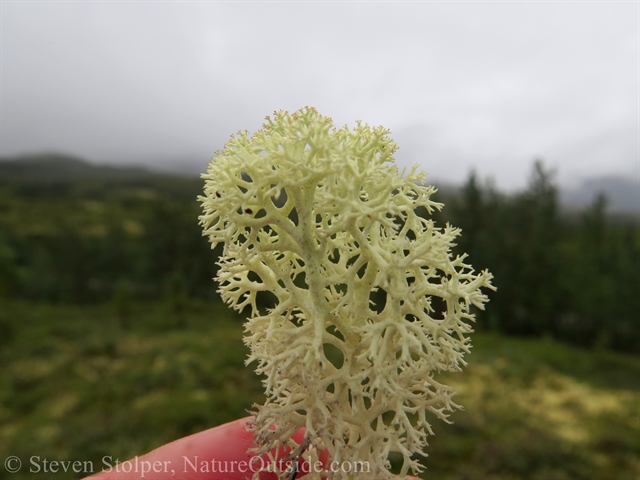
The reindeer moss is beautifully sculptural
The moss and lichen insulate the ground and keep the permafrost frozen. And I’m startled by how deep the mat of Sphagnum moss grows. I easily reach my arm into the moss all the way to my elbow. And I still can’t reach the ground!
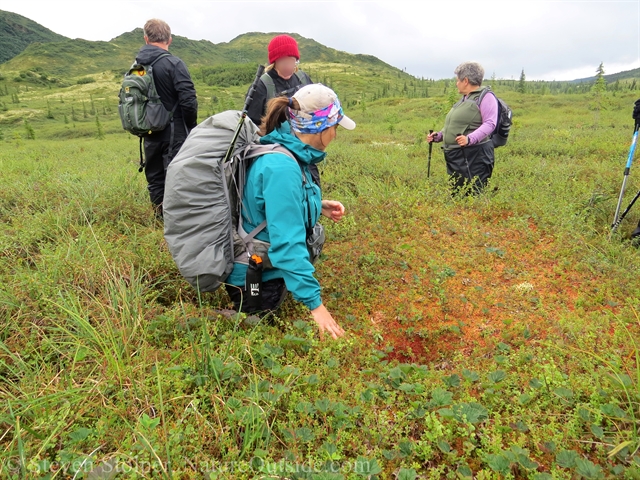
Jenna prepares to reach into a mound of Sphagnum moss
Berries Galore
The number of berries I see on the tundra is dizzying. There are tons of them! In all directions the landscape is decorated with blueberries, crowberries, lingonberries, and cloudberries.
I snack as I hike, and the blueberries are delicious. They’re so sweet! It’s an embarrassment of riches and nearly every step we take lands on a blueberry plant. I feel guilty about treading on a potential food source. But Jenna assures me that there are thousands of acres of blueberries and our excursion will have little impact on the environment.
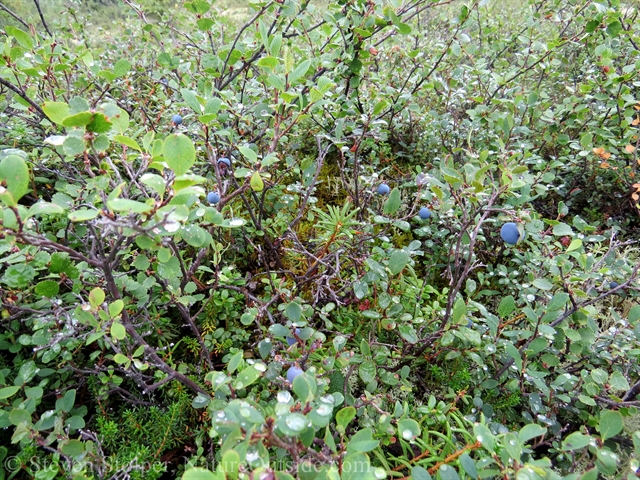
The blueberries grow on low bushes that are mostly ankle high.
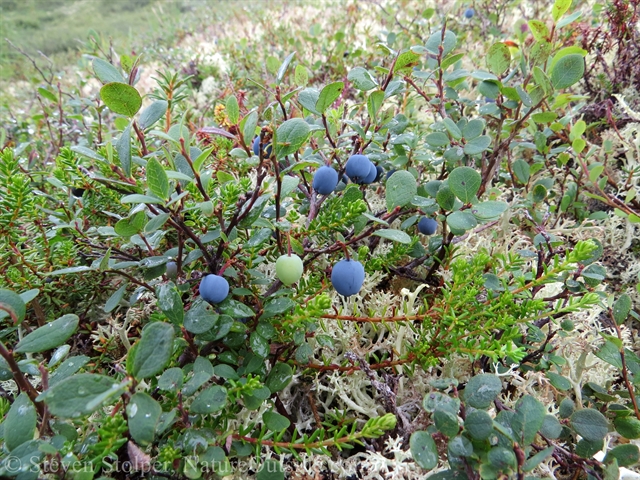
Everywhere I look I find blueberries. Everywhere!
Lingonberries are everywhere, too! Each step reveals candy-apple red berries draped on ankle-high bushes. But the lingonberries are up to mischief. As I pick one, I discover that they’re not quite ripe. The side of the berry facing the sun is tantalizingly red. But the underside remains crabapple green.
I’m disappointed. I was looking forward to savoring them on my trip. I pop a few in my mouth anyway. They’re a little tart, but still very good.
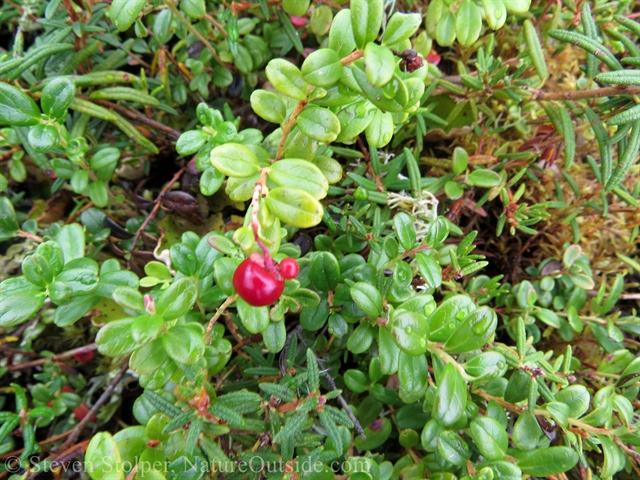
Lingonberry
Growing among the blueberries is the smaller crowberry. It’s diminutive and not as sweet. I sample a few from time to time as I hike. But I’ve already become a berry snob! The blueberries are by far the treat I desire.
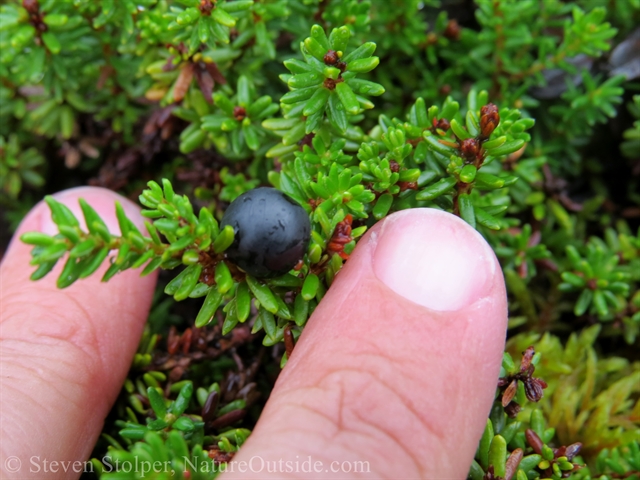
Crowberries are smaller than blueberries and perfectly round.
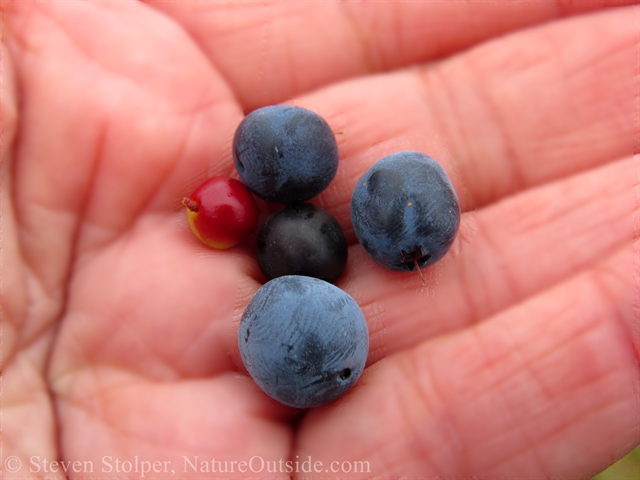
Lingonberry (L), crowberry (C), and blueberries
The most controversial berry is by far the cloudberry. It’s orange-apricot color pops against the lush green field of sphagnum.
Cloudberry looks like the salmonberry I’ve encountered in Washington state, but I can’t be certain it’s the same species. Jenna tells us that a single cloudberry can contain as much vitamin C as an orange!
When I’m issued a warning about the taste of a berry, it grabs my attention. I’ve done my share of gagging and emergency mouth-rinsing. Apparently, the taste of cloudberries stirs strong emotions. Will I love them or hate them? I toss one in my mouth and brace myself.
It’s not bad! Cloudberry tastes like red wine that has just gone off a little. It’s fruity, but with a “vinegary” aftertaste. It’s the aftertaste that throws people for a loop.
A contentious debate ensues within the group. Most seem to be anti-cloudberry. But I like unique tastes and feel grateful to try the cloudberries. Although, the blueberries are still my favorite hands-down!
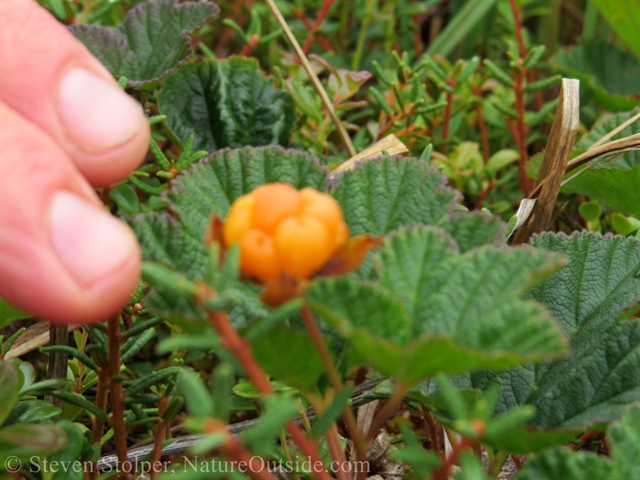
This is a blurry picture of a cloudberry. Imagine an orange-apricot colored raspberry.
Other Edibles
We encounter two more edible plants on the tundra.
Pink Plumes
Pink Plumes (Polygonum bistorta) is aptly named. Even though most of the blooms are spent, I admire the hot-pink spires.
But it’s the five-inch lanceolate leaves we’re looking for. They’re edible raw or cooked. I enjoy munching them while Jenna collects several handfuls. When we return to the lodge, she fries the leaves in olive oil and sprinkles them with salt. They’re like healthy potato chips! I definitely appreciate the scrumptious post-hike snack.
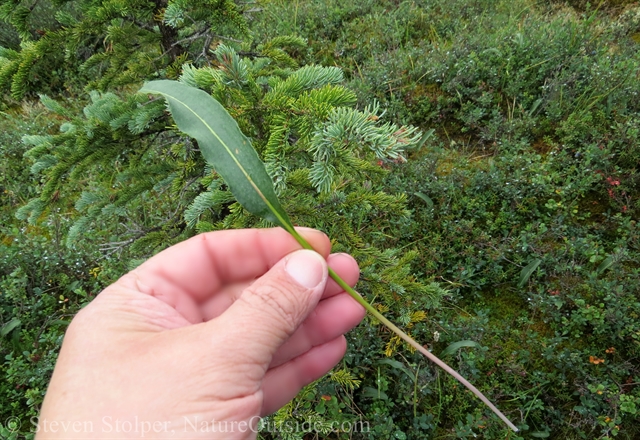
A leaf from Pink Plumes. Notice the long stem. This is a key to look for when identifying the plant.
Labrador Tea
Whenever you hike in nature, you want to cultivate a receptive, observant outlook. You pay attention to your senses and drink-in the land. This includes not just your senses of sight and hearing, but also your sense of smell.
As soon as we start hiking on the tundra, I hear my fellow hikers oohing and ahhing. Each step we take releases an entrancing bouquet! It’s turpentiney-resiny, yet sweetly pungent.
Looking down we find ourselves standing in a patch of Labrador tea (Rhododendron tomentosum). It looks like a piney, low-growing ground cover. The leaves are small, warty, with edges folded down. And on the underside of each leaf is a rusty-orange stripe.
Labrador tea’s aroma comes from essential oils such as ledol, palustrol and myrcene2. These chemicals are thought to repel grazing animals. I love the smell of this plant! To me, it’s the smell of tundra.
Many people drink tea made from the leaves of this plant. I collect some to brew after our hike. I really enjoy the tea. But just the same, I need to be careful. The chemicals in Labrador tea stimulate the central nervous system. And in large doses, they can even cause kidney damage.
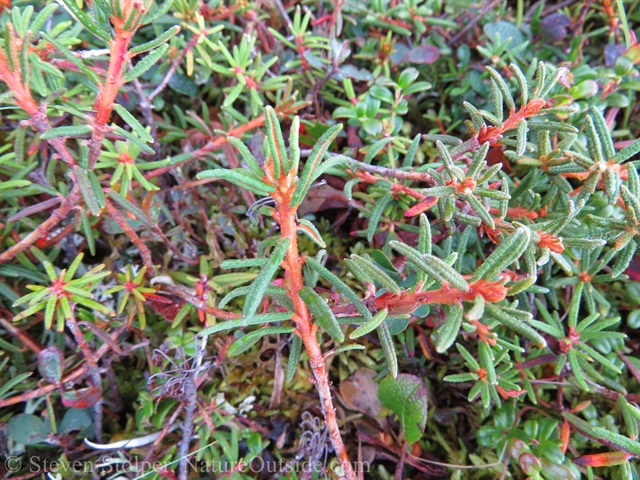
Labrador tea. Notice the rust-colored stripe that runs, lengthwise, down the center of the underside of the leaves.
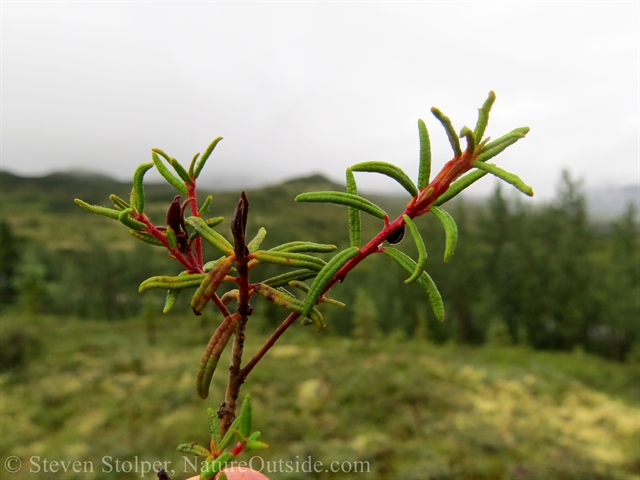
Labrador tea
Bear with Me
Q: What do you call a bear in the rain?
A: A Drizzly Bear!
We head for one of the few hilltops that rise above the uniformly flat tundra. It sits at the transition where the tundra begins to curve upward against a range of rocky ridges. The hill has two crests. Our plan is to hike over the taller one that sits closer to the ridges and stop for lunch on the lower one, which provides the best view of the vast valley.
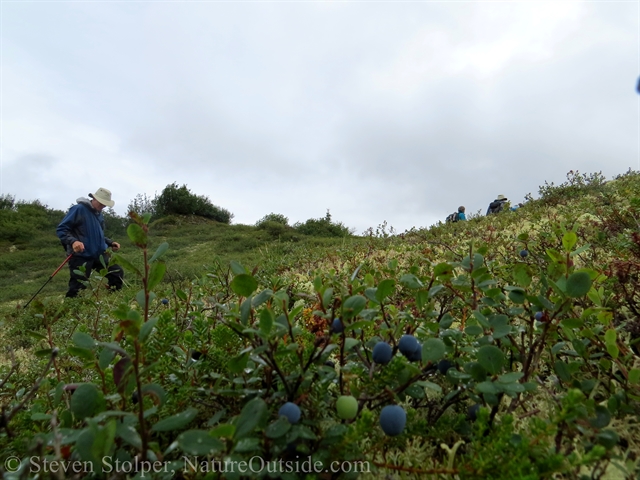
Hiking up to our lunch spot
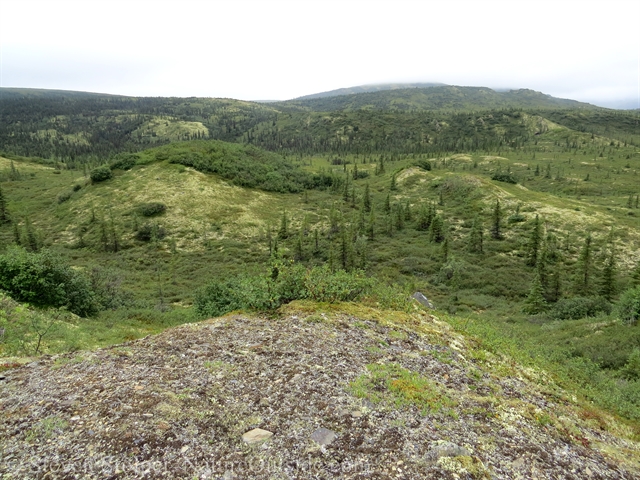
The view from our lunch spot.
As we gain the top of the taller hill, I hear Jenna exclaim, “Is that a wolf?!”
Our eyes shoot upward to the rocky ridge closest to us. I can see a dark silhouette racing along the crest. As we watch, the shape assumes a familiar form. It’s an American black bear!
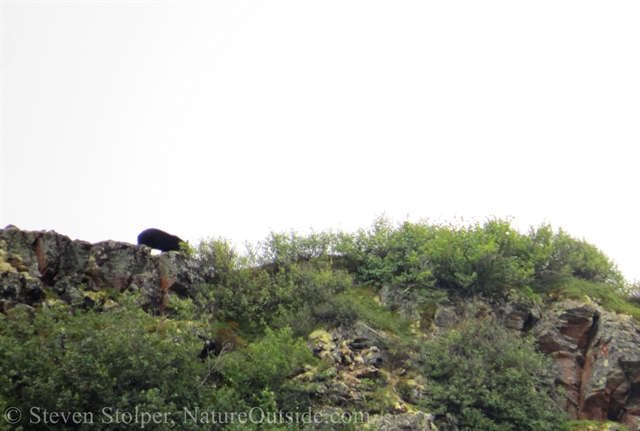
Black bear on the ridge above us
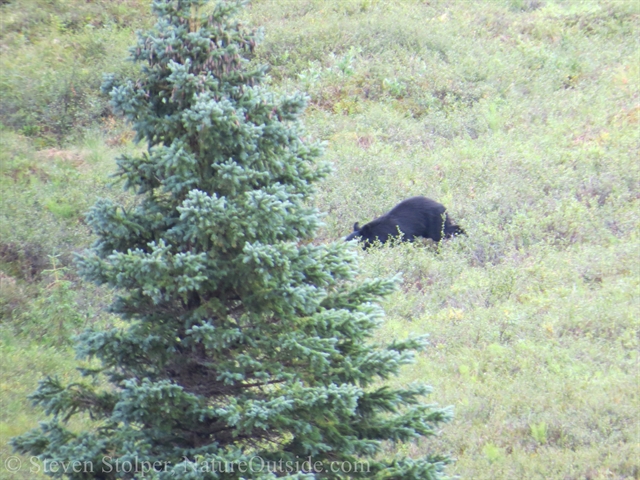
Black bear feeding across from our lunch spot.
We watch it zigzag across the ridge. It’s definitely feeding. Through my binoculars I watch the bear use its teeth to strip branches laden with berries. It remains stationary for a few minutes and then moves with surprising speed to a new copse of bushes.
As long as it continues to move laterally, high upon the ridge, it’s no threat to us. But from our lunch spot on the smaller hill we will lose sight of the bear. This worries Jenna.
We seat ourselves on the smaller hill to enjoy our meal. But Jenna is uneasy. After a few minutes, she returns to the crest of the large hill to keep tabs on our ursine friend.
She returns a few minutes later and informs us the bear is still high on the ridge.
Living in California, I don’t consider Black bears much of a threat. But I’ve been conditioned by my few encounters with them. Each time, I catch a quick glimpse of a “bear behind” as it flees from my approach.
But Jenna lets me know that Black bears in Alaska are different. They’re more inquisitive and unpredictable. And this bear is out in the open, away from its forest home.
Our large group is unlikely to be threatened. But Jenna’s hand wanders to the can of bear spray at her side.
After I finish eating, I head back to the larger hill to observe the bear. I crawl on my stomach the last few feet to the crest. I don’t want to silhouette myself against the sky. I lay on my stomach beneath an alder bush. Using its branches for cover, I glass the ridge above.
What I see alarms me. The bear is running straight down the side of the ridge – directly toward us!
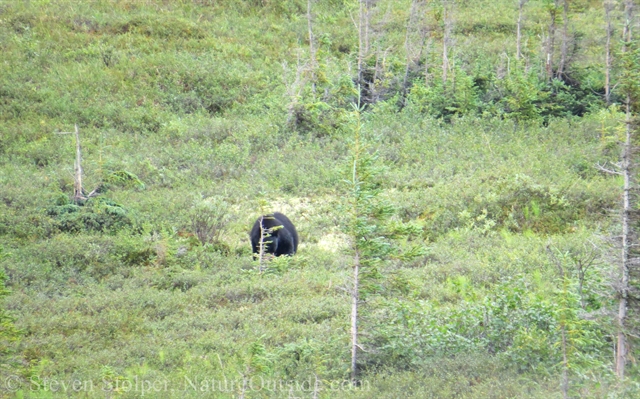
Bear coming toward me. It stops momentarily to feed.
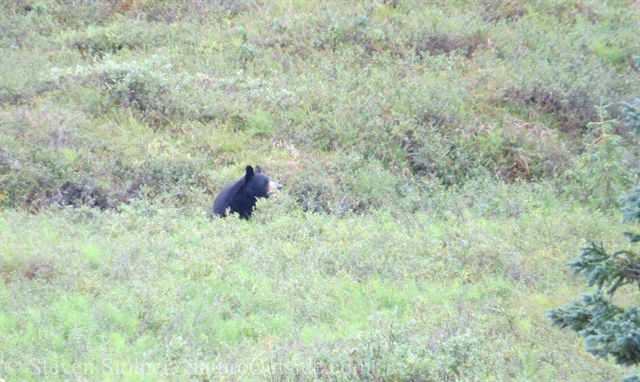
The bear stops to look around. It still hasn’t detected me. I watch it calculating its next move. Which direction will it choose to go?
I scramble back to where the group is eating. Jenna is already walking toward me. I give her the news. But she can already see the bear. It emerges from behind the hill and is directly in front of us. “Everybody get your packs on!”
Jenna watches the bear intently. It’s parked directly in the path she hoped to take after lunch. As she plans our next move, I feel like a dancer in some weird ballet – choreographed by the bear!
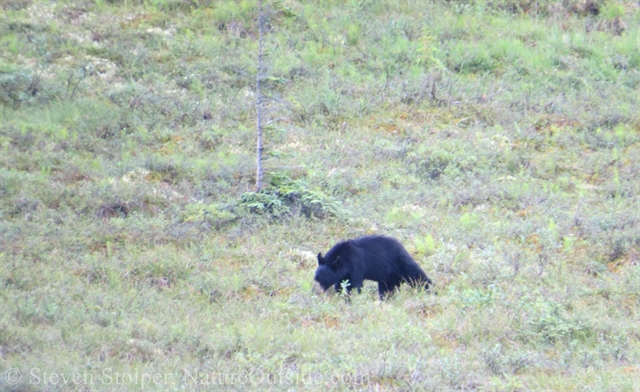
The bear is moving and feeding directly ahead. It’s on the tundra below our hill.
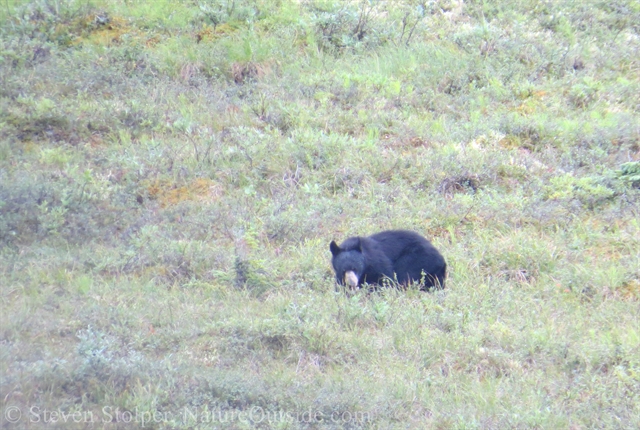
The bear stops momentarily to munch some berries.
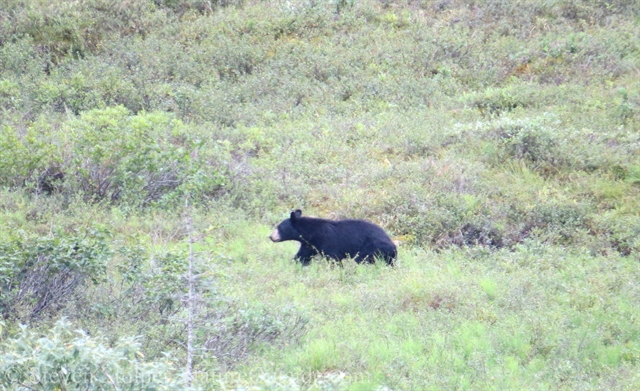
Displaying tremendous energy, the black bear maneuvers in front of us, feeding as it goes.
I feel the breeze on the back of my neck. Oh, oh! The bear is now downwind of us. Surely he’ll catch the scent our group.
Almost on cue the bear reacts. It rises on its hind legs to look in our direction. And then it tears off across the tundra toward Moose Creek.
The bear’s speed is amazing! And I swallow as I recall my plodding steps across the springy tundra.
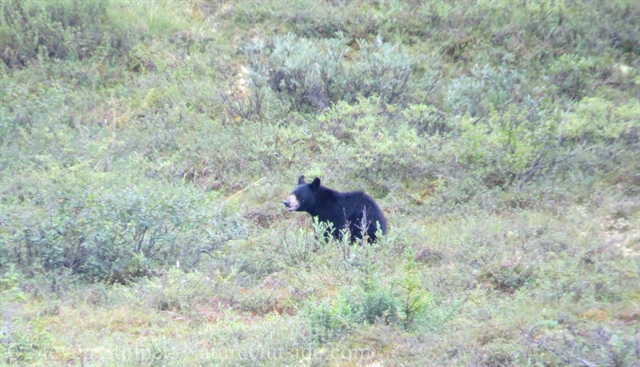
The bear stops momentarily, panting.
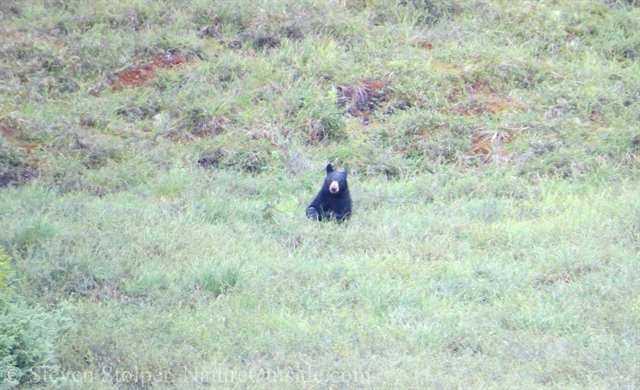
The bear catches our scent. It rears to look in our direction. We are still on the crest of a hill overlooking the tundra.
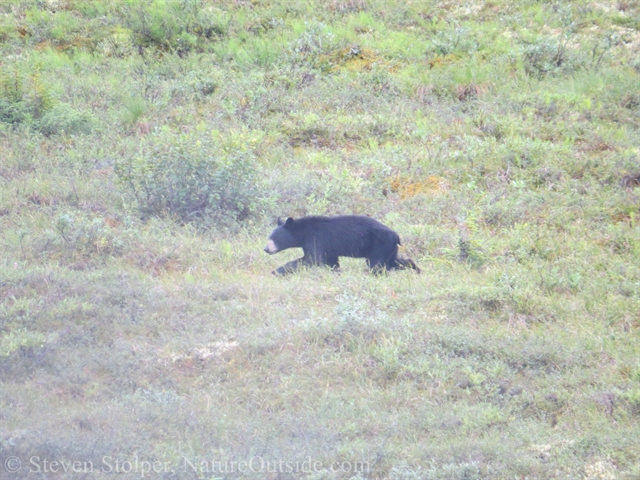
The bear races away in the direction of Moose Creek. It moves with tremendous speed.
Come again Ptarmigan
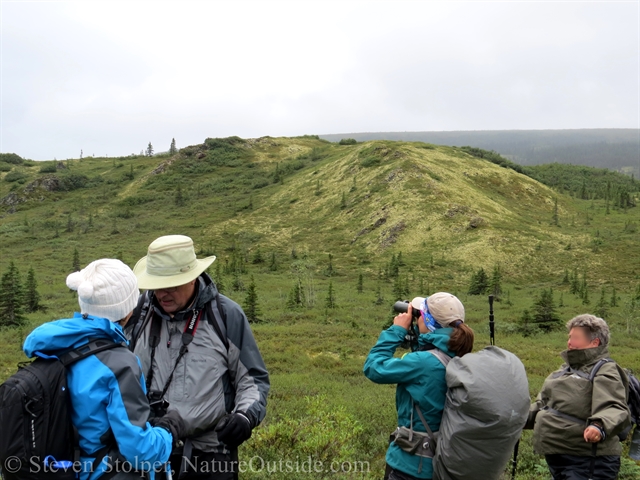
We return to the valley floor.
We descend cautiously from our hilltop and return to the valley floor. It looks like the bear is long gone.
Suddenly, Jenna stops the group. There’s a female ptarmigan just steps from where I stand!
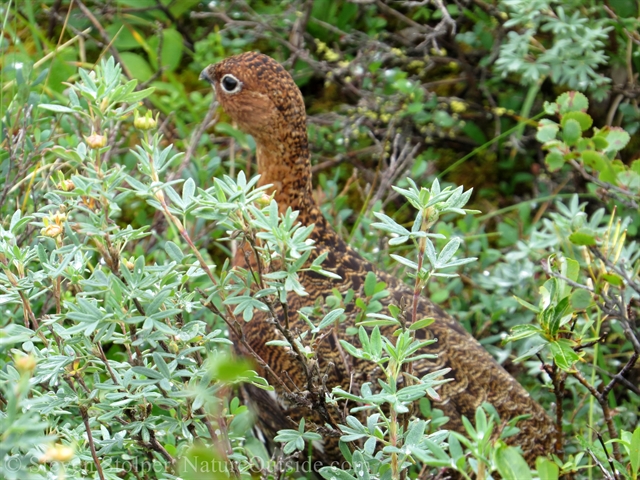
Female ptarmigan, just steps away
I wait for the chicken-size bird to flush. But it remains motionless a few feet away. What’s going on? A California quail would explode from the brush with thunderous wingbeats. And I would have to jump-start my beating heart.
Jenna explains that the ptarmigan is frozen, relying on its camouflage to conceal it from our group. Who does this bird think it’s kidding? Jenna mentions that she knows people who hunt ptarmigan with a sling-shot. I can believe it.
Tussock Tundra
We move onto tussock tundra. Tussocks are mounds of sedge (Eriophorum angustifolium?) around one foot high. These colonies are thicker than the surrounding moss and firmer to walk on. But when you step on them, they have an unfortunate habit of tipping you over!
This makes hiking on tussock tundra a challenge if you don’t have a good sense of balance.
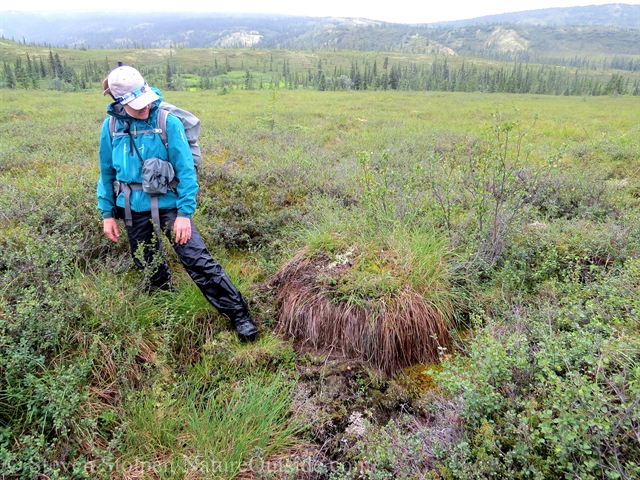
Jenna points out a tussock whose roots are exposed.
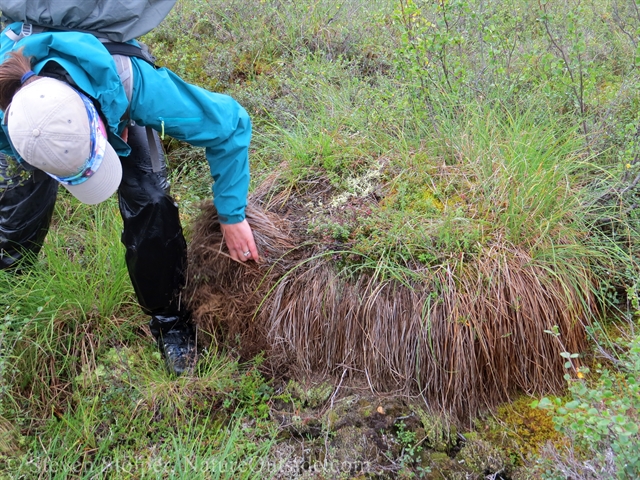
A closer look at the structure of a tussock. It’s comprised of many small sedges.
The soil is warmer and dryer on a tussock than on the surrounding tundra. This means the plants are some of the earliest spring foods available to Caribou.
Other Life on the Tundra
The soil is extremely poor in nutrients. So some plants go to extremes to get the fertilizer they need. Here are some Sundews (Drosera sp.). They’re beautiful carnivorous plants. This is the first time I’ve seen these otherworldy plants in the wild.
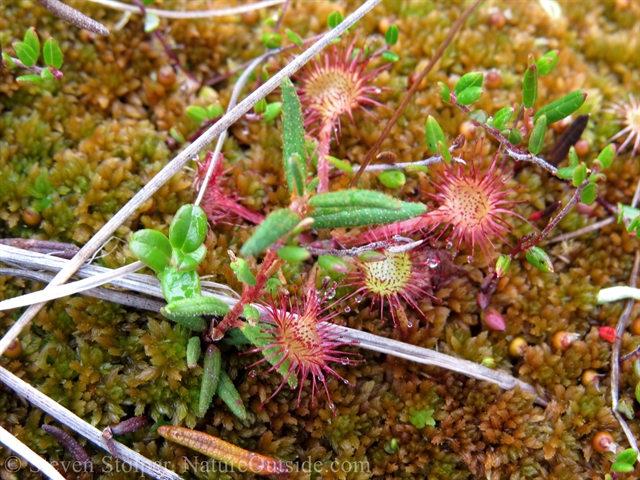
Sundew growing alongside Labrador tea.
We also find an enormous polypore. Once Jenna removes it from the ground, the many insects that live in its tubes abandon ship. It’s like a bad remake of the movie, Titanic!
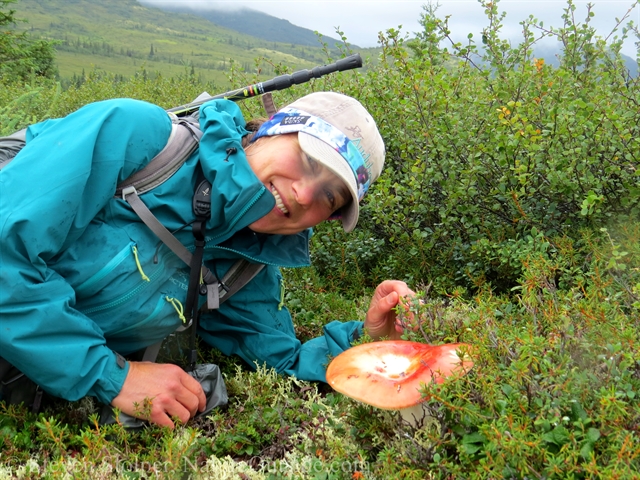
Jenna finds a fungi
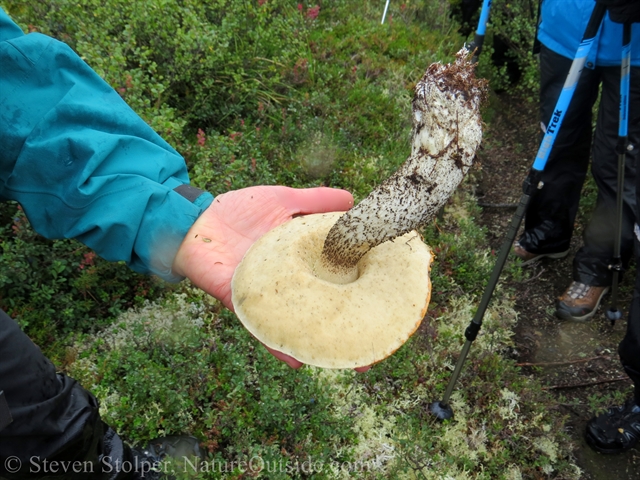
A closer look at the giant mushroom
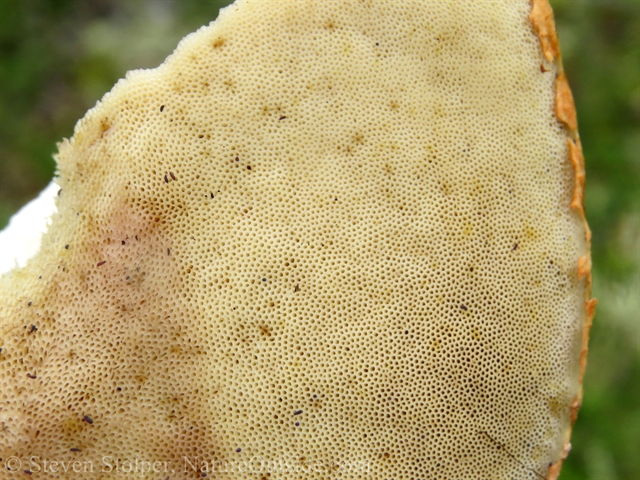
Abandon ship! Many insects lay their eggs and live inside the mushrooms spore ducts.
As we cross the tundra on our way back to the lodge, I snap a few parting pictures.
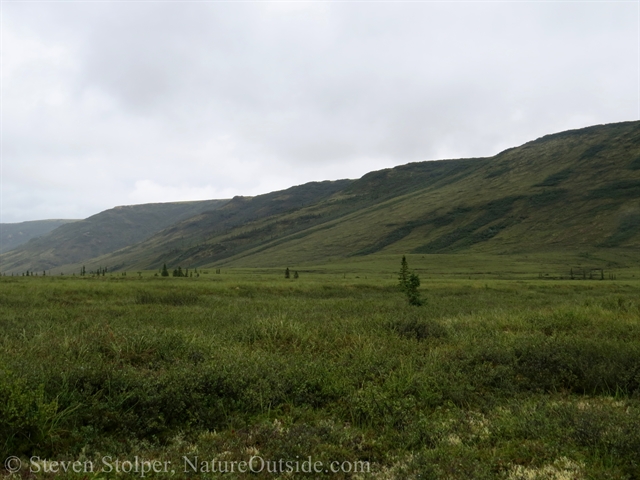
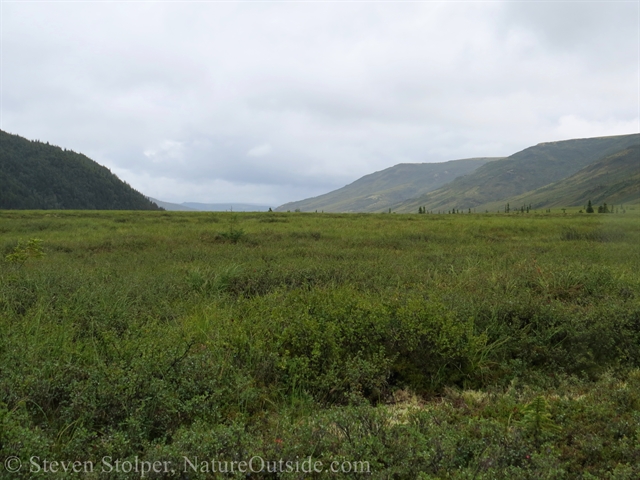
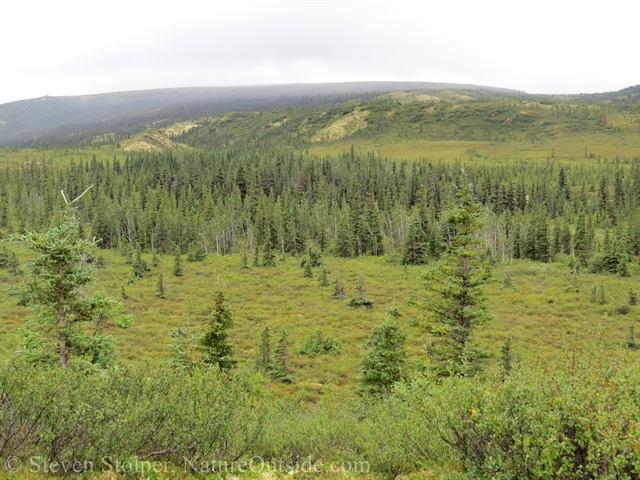
Tundra Damage
Jenna pauses in front of an area of tundra that has dried. It looks terrible – like it’s been burned.
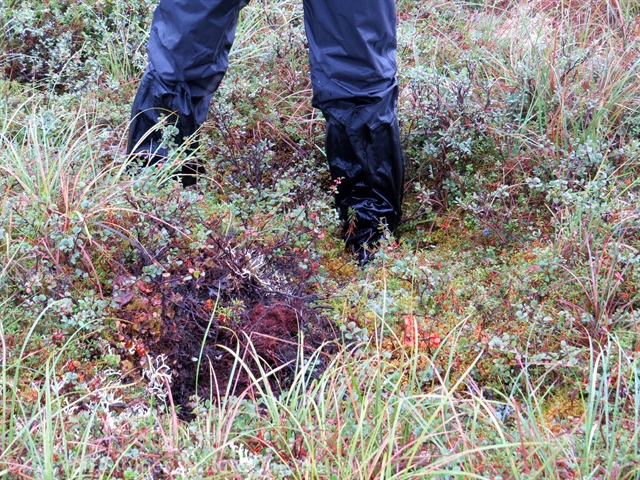
Tundra that has dried
It’s a harbinger of what will happen if the tundra continues to dry. She also shows us Alder, a woody shrub, that has been taking over areas of the tundra where she has never seen it.
These are likely the effects of a warming climate. And it reminds me of our responsibility as people.
I’m likely seeing the effects of human activities that seem a world away from this remote stretch of tundra. Conversely, it’s easy to see how we can overlook the consequences of our actions when their earliest effects are felt so far from home.
I would like everyone to be able to visit tundra like I’ve experienced today. So I hope we pay attention to these signs. Then we must transform our attention into intention to preserve this beautiful tundra for ourselves and for future generations.
More Adventure to come
This hike is only a part of my trip to Denali National Park. As I complete each article, I will add a link below.
Denali – Train to the Wilderness
Denali – The Tale of Ten Bears
Denali – Kettle Ponds and Caribou
References
- NCBI Resources – Aconite Poisoning
- NatureGate – Labrador Tea
- Wildflowers of Denali, Verna E. Pratt and Frank G. Pratt
- The Nature of Alaska, by James Kavanagh
For fun facts and useful tips, join the free Bushcraft Newsletter.



Awesome. The photographs were/are wonderfully explicit and descriptive.
Thanks, Keith! I’m glad you enjoyed the article.
This is so cool… I just moved here to Alaska! Can’t wait for my first summer! Would love to do something like this!
I’m so jealous, Tiffany. Have a great time exploring Alaska!
I’m going to be in Denali July 13 and am looking for a guide. Is it possible to get Jenna’s contact info?
Cheryl, Jenna is the owner of the North Face Lodge, in Denali National Park. You would need to contact her through the North Face Lodge.